Firewood Log Screw Splitter Drill Bit Review
- December 26, 2023
- 0 comment
Splitting logs for firewood can be a tough job, especially when dealing with hard or knotted wood. For years, I relied on traditional tools, but the process was slow and physically demanding. That’s what led me to explore log splitter drill bits a more efficient way to turn raw logs into firewood.
I tried out different drill bits to find what works best. Through research and hands-on testing, I learned which types of drill bits handle tough wood most effectively. Now, I’m here to share the best firewood log splitter drill bits that have made my firewood preparation faster and easier. If you’re looking for a better way to split logs, these tools could be exactly what you need.
Technical Specifications
- Brand: SYWAN
- Material: High Carbon Steel
- Finish Type: Titanium
- Tool Flute Type: Spiral
- Surface Recommendation: Wood, Steel
- Package Dimensions: 6.26 x 1.73 x 1.61 inches; 3.53 Ounces
My Personal Experience with Wood Splitter Drill Bit
I’ve had my eye on this type of wood splitter drill bit for quite some time. They are available in larger configurations designed to attach to the PTO shaft of a tractor, all the way down to smaller units like the one I’ve recently acquired, which is convenient for packing along with camping gear.

Admittedly, I harbored doubts about its effectiveness, not only when dealing with soft, relatively straight-grained pine but also in handling the challenging task of splitting a tough piece of Australian hardwood. As it turns out, my skepticism wasn’t limited to the tool’s performance alone my ankles and wrists would bear the brunt of the effort required to test the efficacy of a Screw Splitter!
The screw of this wood-splitting tool is designed to seamlessly fit into any standard drill or driver, making the setup process straightforward. Once the chuck is securely tightened, the tool is ready for action. The coarse thread of the screw is engineered to autonomously wind itself into the targeted timber, gradually widening the hole or splitting as it advances, with the ultimate goal of splitting the wood in two.
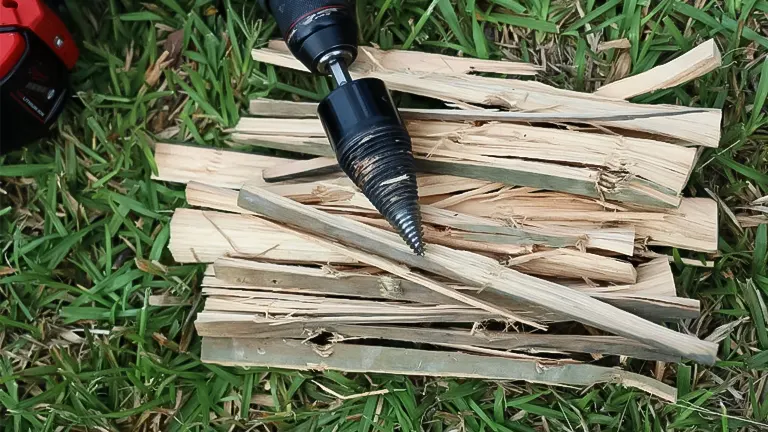
In terms of functionality, the tool proves effective, demonstrating its capacity to split wood. However, like most products, it comes with its set of limitations. The tool faced challenges when confronted with intricately twisted and gnarly pieces of Australian hardwood, resembling unique works of art with no hint of parallel grain. This, however, is not surprising, as even traditional tools such as an axe or log splitter would encounter difficulties with similar pieces.
The Screw Splitter exhibited efficiency in drawing itself into the wood and accomplishing splits of approximately 20 to 30 centimeters in length. Additionally, it offers the flexibility of repositioning if a second hole needs to be drilled, akin to the strategic adjustments one might make when using a second blow with an axe.
Product Examine For Tester
Similar to any tool, using a Screw Splitter requires careful attention to prevent potential injuries, and I experienced both scenarios firsthand in the name of thorough product testing.

Firstly, when the screw embeds itself into timber that resists splitting, maintaining substantial weight and securing your feet is crucial to prevent the wood from rotating and striking your ankles. I personally endured a fair share of blows on both feet.
Secondly, exerting a firm grip on the timber with your feet creates a situation where something has to yield when the screw engages. Instead of the timber rotating and posing a risk to nearby individuals, depending on the drill’s power, the drill attempts to strain your wrists. This, too, proved to be a painful experience.
Notably, the more potent your drill, the greater the potential for self-inflicted harm. This principle aligns with using an axe; a more forceful swing increases the likelihood of accidents. Maintaining a secure grip with both feet and hands is paramount when utilizing this tool. Executed correctly, it efficiently handles various types of timber, although softer, straighter-grain wood proves to be more manageable.
Soft Versus Cranky Ol’Hardwood
The distinction between soft and stubborn hardwood became glaringly evident during the Screw Splitter’s performance. The soft and delicately designed pine timber succumbed effortlessly to the tool’s prowess. Swiftly and without complications, I amassed a substantial pile of kindling, encountering neither damage nor concerns. The Splitter seamlessly navigated through every section of the soft timber, effortlessly producing full-length pieces.
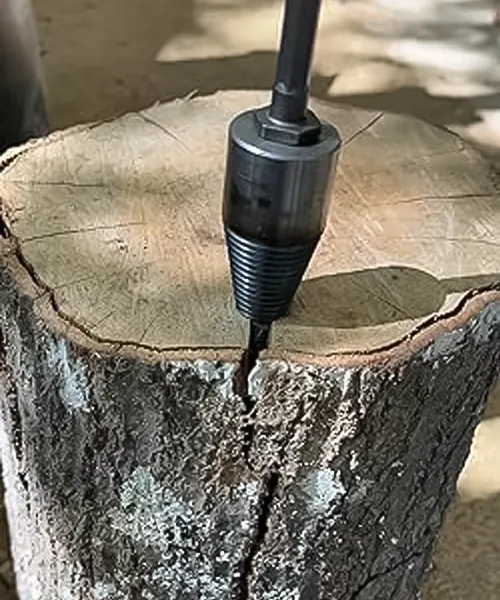
However, the encounter with a piece of hardwood painted a different narrative. Initiating the Screw Splitter’s screw through the heart of the timber resulted in an abrupt halt, as it became firmly lodged deep within the grain. Attempts to reverse the process proved futile, only leading to the loosening of the chuck and the entire splitter dislodging from the drill.
Overcoming this setback required a strategic application of leverage, persistent tries on the drill trigger, and perhaps a touch of colorful language. This experience underscored a valuable lesson: akin to splitting with an axe, adopting a measured approach and taking smaller bites from the outer edges proved to be more manageable.
Adhering to the correct technique eventually allowed me to conquer the resilient lump of hardwood, transforming it into perfect kindling without further mishap. This tale of contrasting outcomes highlights the tool’s proficiency with softer woods while emphasizing the importance of a nuanced strategy when confronted with more challenging hardwoods.
Performance Accuracy
When it comes to performance, the wood-splitting tool under scrutiny excels in handling seasoned softwoods such as pine and spruce. Its efficiency becomes evident when dealing with smaller logs, typically measuring between 4 to 6 inches, as it effortlessly splits them with minimal exertion. This makes the process of obtaining campfire-ready kindling a swift and hassle-free endeavor, allowing for quick and efficient wood preparation.
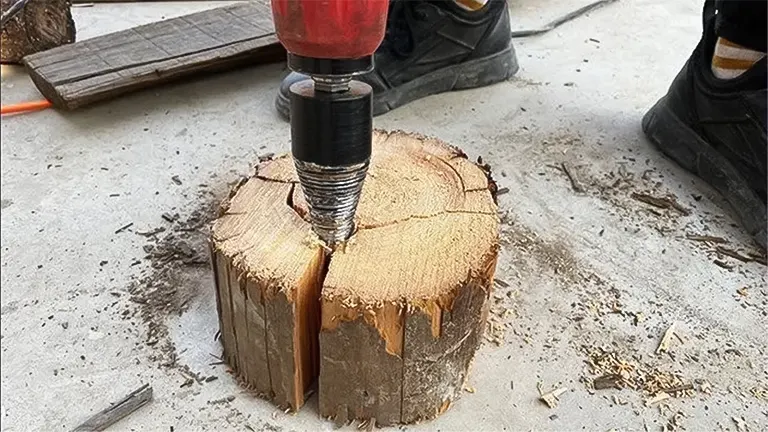
However, the narrative takes a different turn when confronted with the challenge of harder woods like oak or larger logs. The tool faces difficulties in these scenarios, often struggling and binding up during the splitting process. This necessitates a more labor-intensive approach, requiring the operator to engage in a physical struggle reminiscent of a tug-of-war with a Screw Splitter Drill.
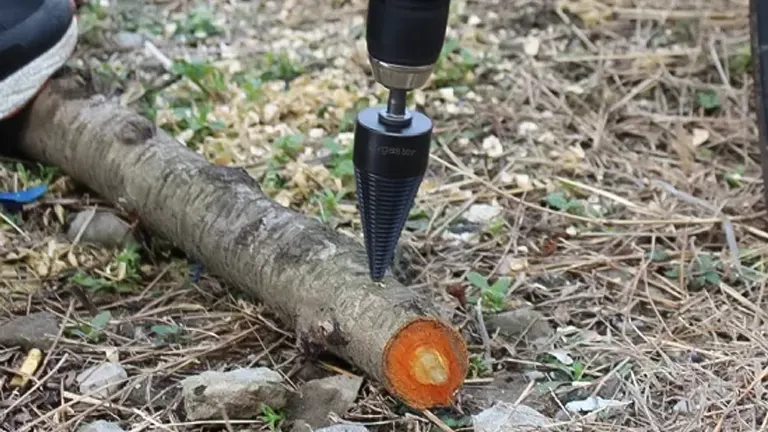
Furthermore, the strain on the equipment becomes apparent, as the trusty 18V drill used in conjunction with the wood-splitting tool begins to exhibit signs of protest. Audible groans and even smoke signals emanating from the drill, signal the potential strain and overexertion on the hardware, highlighting the limitations of the tool when faced with more demanding wood-splitting tasks.
Visual Aspects Review
The Firewood Log Screw Splitter Drill Bit exhibits a design focused on practicality and ease of use. The tool’s shaft is universally compatible, seamlessly fitting into any standard drill or driver, ensuring accessibility for users with a variety of equipment. The straightforward setup involves tightening the chuck, and priming the device for operation.
The coarse thread of the screw distinguishes itself as a key feature, autonomously winding into the targeted timber with each rotation. This not only streamlines the splitting process but also allows for an adaptable approach, as the tool widens the hole or split the further it advances into the wood. Visually, the tool’s construction reflects a thoughtful blend of functionality and durability, with an emphasis on efficient wood-splitting.
The design also incorporates flexibility, as demonstrated by the tool’s ability to reposition itself for a second drilling, reminiscent of the strategic adjustments one might make when using traditional splitting tools. Overall, the Firewood Log Screw Splitter Drill Bit impresses with its user-friendly design and visual appeal, making it a practical choice for those seeking a reliable and efficient wood-splitting solution.
Proper Installation Guidelines
- Select a Compatible Drill: Ensure you use a standard drill or driver that is compatible with the Screw Log Splitter Drill Bit. Verify that the chuck of the drill securely holds the shaft of the splitter to prevent any disengagement during operation.
- Tighten Chuck Securely: Before use, firmly tighten the chuck around the shaft of the Screw Log Splitter. A secure connection is essential to maintain stability and prevent any unintentional detachment during the wood-splitting process.
- Start with Softer Woods: For optimal performance and to acquaint yourself with the tool’s capabilities, begin by using the Screw Log Splitter on softer woods, such as pine or spruce. This will allow you to gauge the tool’s efficiency and get accustomed to its operation.
- Apply Even Pressure: When engaging the Screw Log Splitter with the timber, ensure you apply even and consistent pressure. This helps prevent binding or jamming, especially when dealing with denser or gnarly wood varieties.
- Reposition for Multiple Splits: If splitting larger logs or when additional splits are needed, consider repositioning the Screw Log Splitter to drill a second hole. This can enhance efficiency and provide more control over the wood-splitting process, allowing for versatile applications.
Pros and Cons
Pros
- Easy to use: Attaches to any drill and requires minimal muscle power.
- Great for kindling: Splits smaller, dry softwoods like a champ.
- Portable and compact: No need for bulky mauls or axes.
Cons
- Limited splitting power: Struggles with hardwoods and larger logs.
- Drill strain: Puts serious stress on your drill, especially cordless models.
- Safety concerns: Binding can cause the drill to spin, so hold on tight!
Final Verdict
In the final analysis, the Firewood Log Screw Splitter Drill Bit emerges as a convenient and efficient tool for swift kindling production, particularly well-suited for softer wood varieties. Its performance, while commendable for quick tasks, falls short of being a miraculous solution. Users should temper their expectations, as this tool may not be the ideal choice for managing larger-scale winter firewood supplies.
Additionally, it demands a bit of preparation, as the accompanying drill may require a motivational pep talk before each usage. Despite its limitations, the Firewood Screw Log Splitter Drill Bit remains a handy accessory for specific applications, providing a balance between convenience and practicality in the realm of wood-splitting tools.
Frequently Asked Questions
- What type of drill is compatible with the Firewood Log Splitter Drill Bit?
The Firewood Log Splitter Drill Bit is designed to fit into any standard drill or driver with ease, providing versatility for users with various equipment. - What wood types does the Firewood Log Splitter Drill Bit work best with?
This tool is particularly effective on softer woods, such as pine and spruce, making it ideal for quick kindling production. However, it may face challenges with harder woods like oak. - Can the Firewood Log Splitter Drill Bit handle larger logs for firewood preparation?
While it excels with smaller logs (around 4-6 inches), users should manage expectations as it may struggle with larger or harder wood pieces. Its performance may vary depending on the specific wood type and size. - Is the Firewood Log Splitter Drill Bit suitable for professional use or heavy-duty tasks?
This tool is best suited for lighter, more casual applications like camping or small-scale firewood preparation. For heavy-duty tasks, consider dedicated log splitters or equipment designed for professional use. - How does the Firewood Log Splitter Drill Bit compare to traditional splitting tools like axes or log splitters?
The Firewood Log Splitter Drill Bit offers a quick and convenient alternative for specific tasks, but it may not replace traditional tools for larger or tougher wood-splitting jobs. - What is the recommended technique for using the Firewood Log Splitter Drill Bit?
Users should ensure a secure and tightened fit in the drill chuck. It’s advisable to start with softer woods and gradually progress to harder varieties. Regular repositioning may be necessary for optimal results. - Does the Firewood Log Splitter Drill Bit come with any safety features?
While the tool itself doesn’t have specific safety features, users should follow standard safety precautions when operating power tools, including wearing appropriate protective gear and maintaining a secure working environment. - Can the Firewood Log Splitter Drill Bit be used on irregularly shaped or twisted wood pieces?
The tool may face challenges with highly irregular or twisted pieces of wood. It’s recommended to use it on more uniform sections for better results. - What maintenance is required for the Firewood Log Splitter Drill Bit?
Regular inspection of the tool for wear and tear is advisable. Lubricating the threads and ensuring the drill is in good working condition will contribute to the tool’s longevity. - Does the Firewood Log Splitter Drill Bit come with a warranty?
Warranty terms may vary by manufacturer, so it’s important to check the product documentation or contact the manufacturer for information on warranties and support.
We welcome your input! Feel free to share your firsthand experiences and thoughts on the Firewood Log Splitter Drill Bit in the comments section. Your valuable insights can be instrumental in assisting others as they make decisions about this tool. Let’s build a community where users can exchange information and enhance their understanding of the Firewood Log Screw Splitter Drill Bit. We look forward to hearing from you!

Edward Smith
Forestry AuthorWoodworking is about more than crafting; it's a harmonious connection with nature, mastering tools, and preserving our environment. I'm here to share my knowledge and experiences with you, forging a future where we can embrace wood's beauty and utility while safeguarding our forests' health and diversity.






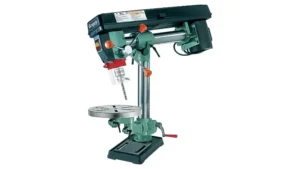


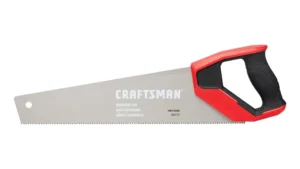
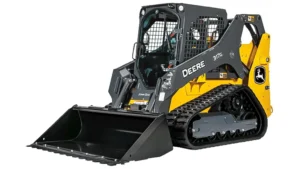
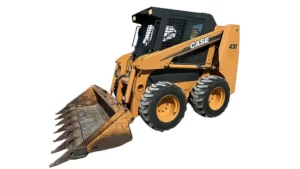
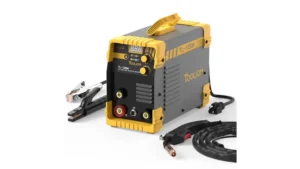
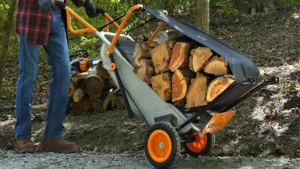
Leave your comment